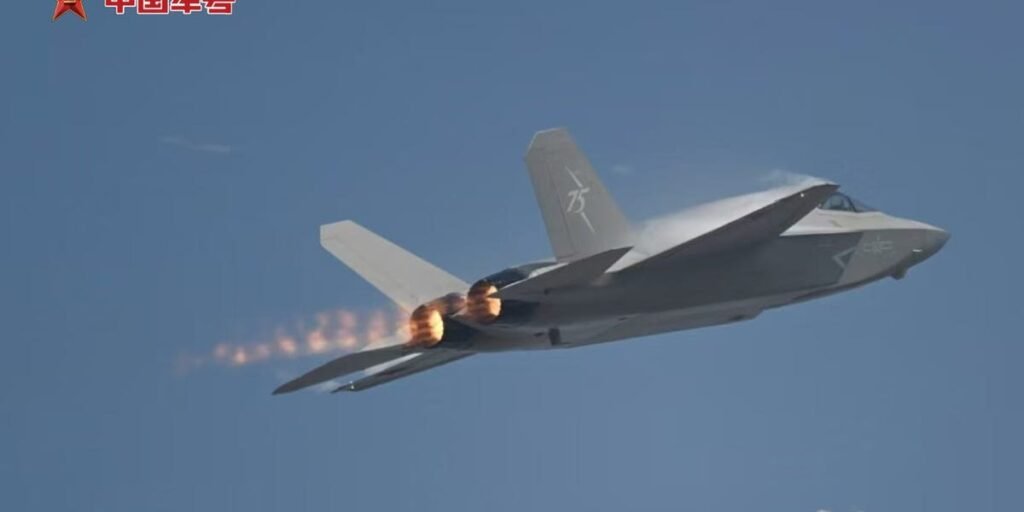- China showed off its new stealth aircraft, including the fifth-gen J-35A.
- The J-35A was described as featuring stealth, informationization, and networking capabilities.
- China’s reveal indicates its ambitions as it works to modernize its military.
China just debuted its newest fifth-generation stealth aircraft, which appears to be its answer to the American F-35.
The J-35A took flight at the China International Aviation and Aerospace Exhibition on Tuesday in Zhuhai. The developer has said the new jet will operate like a “point guard” for Chinese airpower, similar language for the “quarterback” F-35 made by US defense firm Lockheed Martin.
The J-35A, beyond sharing a similar name with the American aircraft, also has a similar design, the twin engines instead of a single turbofan engine aside. A similar appearance doesn’t mean they perform the same though.
The air show was the first official look at the land-based J-35A, a fighter jet that has been in the works, in one form or another, for well over a decade. It’s based on an earlier design prototype that first flew in 2012. That design has been heavily reworked since.
Wang Yongqing, a senior expert with the Shenyang Aircraft Design Institute, part of the Aviation Industry Corporation of China’s Shenyang Aircraft Corporation, told state-affiliated media that the company’s new J-35A has advanced stealth and intelligence features, prioritizing information warfare and collaboration with other aircraft.
Describing the Chinese aircraft as a “basketball point guard,” Wang said that “it not only has a strong point-scoring ability of its own, it also must assess the situation on the court clearly.”
State-affiliated media reported that its missions include air superiority and air-to-air engagements against both fourth- and fifth-generation fighters, intercepts of fighters and bombers, air defense against cruise missiles, ground attack, and the suppression and destruction of enemy air defenses. It is unclear at what level the aircraft can perform these missions.
There is also a carrier-based variant of the J-35. Chinese media reports have said that testing is underway.
At the airshow in Zhuhai, China also unveiled a new version of the PL-15 air-to-air missile made for China’s stealth fighters to carry internally to avoid sacrificing their low-observable characteristics. The Chinese jets will be able to carry six air-to-air missiles in the weapons bay like the F-35As and Cs can.
The US-made F-35 Lightning II has been described by Pentagon and other military officials as the quarterback.
In September, Air Force leadership spoke at the Air and Space Forces Association’s Air, Space, and Cyber Conference about how the F-35’s sensors, stealth capabilities, and other technologies give it a situational awareness that it can share with other aircraft and systems, leveraging not just its own combat capabilities but those of other platforms to wage war.
“It’s the quarterback of the entire fight,” Maj. Gen. Gina Sabric, commander of the 10th Air Force, said at the time.
Stealth aircraft are specifically designed with low-observable features which significantly reduce the size of their radar signatures. This makes them harder to detect and allows them to penetrate enemy air defenses, making stealth aircraft a priority for many militaries.
For stealth fighters, the US has the F-22 Raptor and F-35, and the latter is used by allies around the world. China has developed its J-20, a new two-seat version of which was revealed at the air show, and the new J-35, and Russia has its Su-57. The Russian jet also made an appearance in Zhuhai.
Among stealth aircraft, there are also stealth bombers like the American B-2 Spirit and B-21 Raider and a number of stealth drones. In Zhuhai, China revealed an updated design for its stealthy CH-7 drone.
The unveiling of the J-35A shows how China is continuing its push to challenge US military capabilities.
Just last month, two Republican senators, Roger Wicker and Eric Schmitt, warned that the Chinese military was “on the cusp of world-changing air capabilities” and said the US Air Force had taken its “air superiority for granted.”
They argued that as China continues its military advances, the US may struggle in a potential future fight. “If conflict erupts, China may be able to bracket off the Western Pacific, striking our bases with salvos of missiles and using state-of-the-art air-defense batteries to keep our aircraft at bay,” they said.
Beijing’s military ambitions have been on Washington’s radar for years now, with the Pentagon referring to China as its “pacing challenge” and preparing for the possibility of conflict in the Indo-Pacific region.
A potential flashpoint for conflict between the US and China continues to be Taiwan. The US has assessed that China’s military has been directed to be prepared for potential military action against Taiwan by 2027. While that date doesn’t indicate when or if a conflict would occur, it has pushed the US to prioritize challenging China’s developments.
Read the full article here


